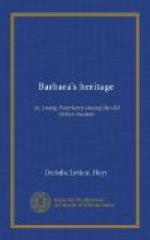Soon they went to the Cathedral; admired its facade, decorated with mosaics in softly brilliant colors until it looked like a great opal, shining against the deep blue sky; entered it and saw Fra Angelico’s grand Christ, and calm, holy saints and angels; and, close to them (the most striking contrast presented in art), Luca Signorelli’s wild, struggling, muscular figures.
They went into the photograph store on the corner for photographs, and to the little antique shop opposite, where they bought quaint Etruscan ornaments to take away as souvenirs,—and then gave themselves to exploring the city; after which they all confessed to having fallen somewhat under the spell of its charm.
The next afternoon found them on their way, around Lake Trasimeno, to Perugia.
Little had been said about this city, for their conversation had been engaged with those they had left behind. Malcom, only, had been looking up its history in his guide-book, and was interested to see the place that had been bold enough to set itself up even against Rome, and so had earned the title “audacious” inscribed on its citadel by one of the Popes.
“Magnificent in situation!” he exclaimed, and his eager eyes allowed nothing to escape them, as their omnibus slowly climbed the high hill, disclosing wide and ever widening views of the valley of the Tiber.
“I think,” said Mr. Sumner, who was enjoying the delighted surprise of his party, “that Perugia is the most princely city in regard to position in all Italy. It is perched up here on the summit as an eagle on his aeried crag, and seems to challenge with proud defiance these lower cities, that, though each on its own hill-top, look as if slumbering in the valley below.”
When a little later they were ushered into the brilliantly lighted dining-room, which was filled almost to overflowing with a gayly dressed and chattering crowd of guests, most of whom spoke the English language, all the way thither seemed as a dream. Only the voluminous head-dresses of the English matrons, and the composite speech of the waiters, told them surely that they were in a foreign land.
The next day, after a drive through the city, whose different quarters present some of the most interesting contrasts to be found in all Italy, Mr. Sumner took them to the Pinacoteca, or picture-gallery, and before looking at the pictures, told them in a few words about the early Umbrian school of painting.
“It grew out of the early Florentine, and is marked by many of the same characteristics. It was, however, much modified by the Sienese painting. It has less strength, as it has also, of course, less originality, than the Florentine. Its color, on the other hand, is better, stronger, and more harmonious. Its works possess a peculiar simplicity and devoutness—much tranquillity and gentleness of sentiment. This gallery is filled with examples of its masters’ painting. It just breathes forth their spirit, and the best way to absorb it would be to come, each one of us alone, and give ourselves up to its spell. This is no place for criticism; only for feeling. Study particularly whatever you find of Francesca’s, Perugino’s and Bonfiglio’s work.




